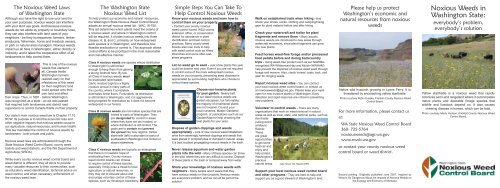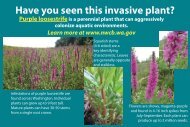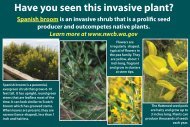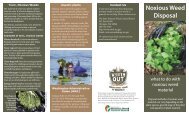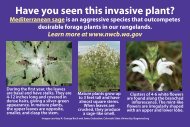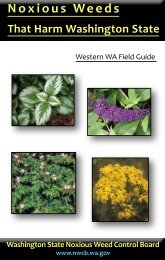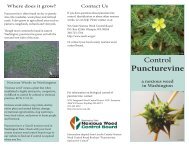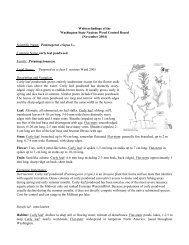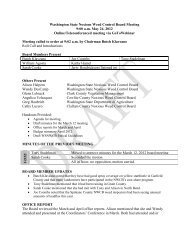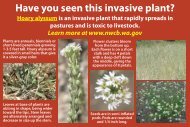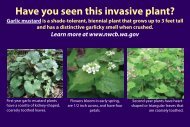Noxious Weeds In Washington State – Noxious Weed Control
Noxious Weeds In Washington State – Noxious Weed Control
Noxious Weeds In Washington State – Noxious Weed Control
You also want an ePaper? Increase the reach of your titles
YUMPU automatically turns print PDFs into web optimized ePapers that Google loves.
The <strong>Noxious</strong> <strong>Weed</strong> Lawsof <strong>Washington</strong> <strong>State</strong>Although you have the right to use your land foryour own purposes, noxious weeds can interferewith your land use goals. And because noxiousweeds do not abide by property or boundary lines,they can also interfere with land uses of yourneighbors - be they homeowners, farmers, timberproducers, fishermen, horse and livestock owners,or park or natural area managers. <strong>Noxious</strong> weedsimpact us all here in <strong>Washington</strong>, either directly orindirectly, and it takes the cooperative effort of alllandowners to help control them.This is one of the noxiousweeds that started itall, Canada thistle.<strong>Washington</strong> farmersrealized early on thatinfestations of this weedon their neighbors’ landcould spread onto theirown land and affecttheir crops. Thus, in 1881 - before <strong>Washington</strong>was recognized as a state - an act was passedthat required both landowners and district roadsupervisors to control Canada thistle on their property.Our state’s main noxious weed law is Chapter 17.10RCW. Its purpose is to limit the economic loss andother negative impacts that noxious weeds cause toour agriculture, natural resources, and human health.This law mandates the control of noxious weeds bylandowners - both private and public.<strong>Noxious</strong> weed laws are administered through the<strong>State</strong> <strong>Noxious</strong> <strong>Weed</strong> <strong>Control</strong> Board, county weedboards and weed districts, and the WA Department ofAgriculture (WSDA).While every county noxious weed control board andweed district is different, they all strive to providemany valuable resources to their communities, suchas education, weed identification, technical advice onweed control, and when necessary, enforcement ofthe noxious weed laws.The <strong>Washington</strong> <strong>State</strong><strong>Noxious</strong> <strong>Weed</strong> ListTo help protect our economy and natural resources,the <strong>Washington</strong> <strong>State</strong> <strong>Noxious</strong> <strong>Weed</strong> <strong>Control</strong> Boardadopts an annual noxious weed list - WAC 16-750.This list determines which plants meet the criteria ofa noxious weed, and where in <strong>Washington</strong> controlwill be required. It divides noxious weeds into threeclasses: A, B, and C, primarily on how widespreadeach species is in <strong>Washington</strong>, and therefore howfeasible eradication or control is. This approach allowscontrol efforts to be prioritized in the most reasonableand cost-effective manner.Class A noxious weeds are species whose distributionin <strong>Washington</strong> is still limitedenough to keep them from gaininga strong foothold here. By law,all Class A noxious weeds mustbe eradicated (eliminated).Garlic mustard (right) is a highlyinvasive annual in many parts ofthe country, where it completelydominates forest floors. Fortunately, its distributionis still limited in <strong>Washington</strong>, and it is aggressivelybeing targeted for eradication so it does not becomewidespread in our forests.Class B noxious weeds are non-native species that arelimited to parts of <strong>Washington</strong>. Theyare designated for control in areaswhere they have not yet invaded, orwhere distribution is still limited. Thegoals are to contain and preventthe spread into new regions. Yellowstarthistle (left) is abundant in parts ofsoutheastern <strong>Washington</strong> but limited orabsent elsewhere.Class C noxious weeds are typically so widespreadthat there is no realistic hope oferadicating them. County noxiousweed control boards can chooseto require control of these species,especially if they pose a threat to localagriculture or natural resources, orthey may opt to educate about andencourage voluntary control of thesespecies, such as Himalayan blackberry.Simple Steps You Can Take ToHelp <strong>Control</strong> <strong>Noxious</strong> <strong><strong>Weed</strong>s</strong>Know your noxious weeds and learn how tocontrol them on your property- Contact your county noxiousweed control board, WSU countyextension office, or conservationdistrict for assistance in plantidentification and best controlpractices. Many county weedboards also loan tools to helpwith weed control such as <strong>Weed</strong>Wrenches and some offer costshareprograms.Let no weed go to seed - Just a few plants this yearcould be dozens next year. Even if you are not requiredto control some of the more widespread noxiousweeds on your property, preventing seed dispersal isappreciated by surrounding neighbors who choose tocontrol these species.Choose non-invasive plantsfor your garden Nearly halfof our listed noxious weeds aregarden escapees, but fortunately,the majority of ornamental plantsare not invasive. Consult yourlocal nurseries, Master Gardenerprogram, or publications such as ourGardenWise for help choosing thebest plants for your area.Dispose of garden clippings and weedsappropriately - Lots of new noxious weed infestationsarise from seemingly harmless clippings and seeds thatwere placed in compost piles or dumped in natural areas.It is best to place propagating noxious weeds in the trash.Never release aquarium and water gardenplants into the wild - Many of these species can thrivein the wild, where they are very difficult to control. Disposeof these plants in the trash or compost away from water.Share your knowledge of noxious weeds withneighbors - Many people aren’t aware that theyhave noxious weeds on their property. <strong>Noxious</strong> weedsare everyone’s problem, and we can all be part of thesolution.Walk on established trails when hiking - Andcheck your shoes, socks, clothing and camping/hikinggear for plant material before and after hiking.Check your watercraft and trailer for plantfragments and remove them - Many aquaticnoxious weeds are introduced to new areas throughwatercraft movement, since plant fragments can growinto new plants.Feed horses weed-free forage and/or processedfood pellets before and during backcountrytrips - Using weed-free product such as our NAWMArecognizedWA Wilderness Hay and Mulch (WWHAM)help prevent the dispersal of noxious weed seed throughforage and manure. Also, check horses’ coats, tack, andgear for clinging seeds.Report noxious weed sites - You can contactyour local noxious weed control board, or contact usat noxiousweeds@agr.wa.gov. Please keep your eyesopen for new invasive plants in <strong>Washington</strong>. Earlydetection and rapid response are critical in preventingnew problems.Volunteer to control weeds - There are manyorganizations that work on weed removal in naturalareas as well as local, state, and national parks, such asthis thistlepullingeventat MountRainier.Theseare greatopportunitiesto get somefresh air andenjoy andhelp protect<strong>Washington</strong>’spreciousnatural areas. Julie Hover, Mt. Rainier NPSSupport your local noxious weed control boardand other programs - They are here to help andsupport you as a good steward of <strong>Washington</strong>’s land.Please help us protect<strong>Washington</strong>’s economic andnatural resources from noxiousweedsNative wild hyacinth growing in Lyons Ferry. It isthreatened by encroaching yellow starthistle.Photo courtesy Robin Kusske, Franklin County <strong>Noxious</strong> <strong>Weed</strong><strong>Control</strong> Board.For more information, please contact usat:WA <strong>State</strong> <strong>Noxious</strong> <strong>Weed</strong> <strong>Control</strong> Board360- 725-5764noxiousweeds@agr.wa.govwww.nwcb.wa.govor contact your county noxious weedcontrol board or weed district.Second printing. Originally published June 2007. <strong>In</strong>spired byWhat Is So Dangerous About the Impacts of <strong>Noxious</strong> <strong><strong>Weed</strong>s</strong> onthe Ecology and Economy of Montana.<strong>Noxious</strong> <strong><strong>Weed</strong>s</strong> in<strong>Washington</strong> <strong>State</strong>:everybody’s problem,everybody’s solutionYellow starthistle is a noxious weed that rapidlycolonizes semi-arid rangeland where it outcompetesnative plants and desirable forage species thatwildlife and livestock depend on. It also causeschewing disease in horses, which can be fatal.Photo courtesy Marty Hudson, Klickitat County <strong>Noxious</strong> <strong>Weed</strong><strong>Control</strong> Board.
What are <strong>Noxious</strong> <strong><strong>Weed</strong>s</strong>?“<strong>Noxious</strong> weed” is the traditional legal term forinvasive plants that are difficult to control and aredestructive to <strong>Washington</strong>’s agriculture and naturalresources. <strong>Noxious</strong> weeds include non-nativeinvasive herbaceous plants, trees and shrubs, andaquatic plants. Once established, these invasiveplants can colonize our cropland, rangeland,forests, parks, wetlands, estuaries, and waterways,causing economic and ecological damage thataffects us all in <strong>Washington</strong>. That’s why everyone- homegardeners,farmers,public landmanagers,foresters, andranchers -have a roleto play inthis effort toprevent andcontrol the spread of noxious weeds, such as rushskeletonweed (above).The various impacts of noxious weeds are almostas numerous as the weeds themselves. Althoughthe effects of noxious weeds are often separatedinto economic, environmental, and healthcategories, the three are interrelated. And whilesome noxious weed impacts can be measuredwith a dollar sign, many are too complex to fullycalculate, particularly those affecting natural areas.The floating aquatic noxious weed water primrose (above)clogs waterways and ditches and is costly to control.<strong>Noxious</strong> <strong><strong>Weed</strong>s</strong> Really Hurt UsWhere It Counts: Our Wallets<strong>Noxious</strong> weeds are a problem for all of us, from farmersto urbanites and their impacts cost us, both directly andindirectly. According to a study by the Oregon Dept. ofAgriculture, noxious weeds reduced that state’s personalincome by an estimated $83 million in 2000, and the lossin production caused by these weeds could eliminate anestimated 3,000 jobs per year.Many noxious weeds can significantly reduce propertyvalues. A classic example in the Pacific Northwestis a ranch that sold in auction in 1988 for only about10% of its original worth after becoming overrun withthe noxious leafy spurge (below). <strong>Noxious</strong> weeds arealso costly in suburban and urban areas. For example,invasive knotweeds can grow through pavement, pipes,and septic tanks, causing damage to infrastructure. Andwe all pay for weed control along roadways and utilityright-of-ways, where they reduce visibility and access.Utah <strong>State</strong> University Archive,Utah <strong>State</strong> University, Bugwood.org<strong>Noxious</strong> weeds also cost farmers, ranchers, andorchardists millions of dollars in control efforts and lostcrop production, which can contribute to higher pricesof food for all of us. <strong>In</strong>vasive knapweeds and yellowstarthistle outcompete forage species, reducing grazingquality of rangeland and pastures. <strong>In</strong>festations of thesespecies result in an estimated loss of $950,000 in forageproduction in eastern <strong>Washington</strong>. The cost to providehay to replace the lost forage is an additional estimated$2 million.The majority of forested land in <strong>Washington</strong> iscommercial timberland,and some noxious weedsinterfere with the reforestation process. For example,it was estimated in 2000 that Scotch broom alone costOregon $47 million in reduced timber production everyyear.<strong>Noxious</strong> <strong><strong>Weed</strong>s</strong> Threaten OurNative Plants and EcosystemsWith over 4 million acres of Wilderness Area and120,000 acres of natural areas, <strong>Washington</strong> has beenable to preserve many of its diverse ecosystems.While many pieces of land have been set aside andprotected from development and disturbance, noxiousweeds are still a constant threat. Many of theseinvasive plants adapt to many different environments,and they readily invade our natural areas where theyoutcompete our native vegetation for space, availablesunlight, water, and nutrients. Many noxious weeds formdense monocultures, dramatically reducing biodiversityand often changing the way healthy ecosystems hadfunctioned.Some noxious weeds, such as spotted knapweed, garlicmustard, and several ofthe invasive hawkweeds(right), can exudeherbicide-like chemicalsthat prevent other plantsfrom germinating. So, theynot only make grasslandsand rangelands lesspalatable for grazinganimals by displacingforage species, but theythen make reestablishment of native plants difficult whilethe invasive species are present.Several knotweed species have been invading ourriparian habitat, particularly in western <strong>Washington</strong>.These fast-growing invasive plants can transformriverbanks by restrictingaccess to water,increasing soil erosion,displacing nativevegetation, reducingavailable sunlight, andaltering the nutrientcycle. The degradationof habitat caused bynoxious weeds posea serious threat to our native plants, as well as salmonand other wildlife. And many state endangered andthreatened species such as golden paintbrush andshowy stickseed are displaced by encroaching noxiousweeds such as Scotch broom and Dalmatian toadflax.<strong>Noxious</strong> <strong><strong>Weed</strong>s</strong> ReduceWildlife Habitat<strong>Noxious</strong> weeds can take over native plant communitiesor establish themselves as dominant species where fewplants had been able to grow before. They can changethe habitat upon which our native <strong>Washington</strong> wildlifedepends for food and shelter. Some species such asScotch broom, gorse, knotweeds, Scotch thistle, andHimalayan blackberry form physical barriers that restrictwildlife movement.Purple loosestrife is a well-studied noxious weed thatillustrates how far-reaching the impacts of an invasiveplant can be. This wetland invader forms dense standsand outcompetesnative species,reducing necessaryhabitat for waterfowl,songbirds, smallmammals, andamphibians.Recent studiesare helping us tounderstand waysthat this speciesupsets the foodweb. For example,it may directly harmtadpoles with tannins in its leaf litter. But decompositionof this plant releases different nutrient levels than somenative wetland plants, which affects the types of algaespecies available for the tadpoles to feed on.Many aquatic andwetland noxious weedsdegrade aquatic habitat.For example, the noxiousweed parrotfeatherforms dense mats thatcan choke streams andponds, reduce water flowand oxygen levels inthe water, and displacenative aquatic plantcommunities, which hadprovided valuable habitatfor fish, amphibians,invertebrates, and otherwildlife.L. Scott<strong>Noxious</strong> <strong><strong>Weed</strong>s</strong> AffectRecreational Activities<strong>Washington</strong> <strong>State</strong>’s abundance of pristine landscapesand diverse ecosystems attract many visitors who cometo enjoy our beautiful natural areas and recreationalactivities. <strong>In</strong> fact, about 48 million people visited ourstate and national parks in 2006. <strong>Noxious</strong> weedshave a negative effect on many outdoor activitiesand on tourism, which impacts the livelihood of many<strong>Washington</strong>ians.Rangeland invadersoutcompete the nativeplants that game animalsdepend on. For example,spotted knapweed (right)can reduce the foragequality of areas by up to90% for elk and deer. Thelack of forage forces themto search elsewhere forfood and affects huntingand wildlife viewingopportunities. And noxiousweeds such as knapweeds,knotweeds, and thistlesblock trails and restrictaccess to waterways.Puncturevine is a noxiousweed that is right at home onroad shoulders and trails. Itssharp-spined seeds can rip rightthrough tires, stick to shoes,and really hurt when touched,making it a real nuisance forbicyclists, hikers, and parkvisitors.Aquatic noxious weeds can be problematic for watersports enthusiasts. They limit swimming areas, blockwaterways for boatersand paddlers, and clogboat propellers. Plants likeEurasian watermilfoil (right)can ruin anglers’ favoritefishing spots by degradingfish habitat.Gary KramerSome <strong>Noxious</strong> <strong><strong>Weed</strong>s</strong> are Toxicto People and AnimalsSome noxious weeds are toxic, and in some cases,deadly. The fact that many of these plants rapidlycolonize disturbed areas and spread into neighboringproperties makes them even more troublesome. To learnmore about toxic noxious weeds and how to identifythem, please go to our website, or contact your countynoxious weed control board or WSU extension office.Poison hemlock is a fatally toxic plant to both peopleand animals. It contains the alkaloid coniine, which isa neurotoxin that affects the nervous system. <strong>In</strong> 2010,one person died and severalpeople were hospitalized formistakenly eating or beingexposed to this noxiousweed. Livestock are alsovulnerable, and this cow wasa victim of poison hemlockingestion.Giant hogweed had once been a favorite ornamentalplant, due to its unusually large size.However, contactwith the toxic sapcan leave painful,third-degree burnson the skin thatcan often leavescars.Tansy ragwort is poisonousto cattle, horses, and sheep.It contains alkaloids thataccumulate in the liver,ultimately resulting in chronicliver failure. Unfortunately,many people do not removeit from their pastures,thinking that their animalswill only graze around thenoxious weed. What theydon’t realize is that livestock cannot always avoid eatingthe low-growing and highly toxic rosette leaves, whichcan eventually lead to liver damage.


